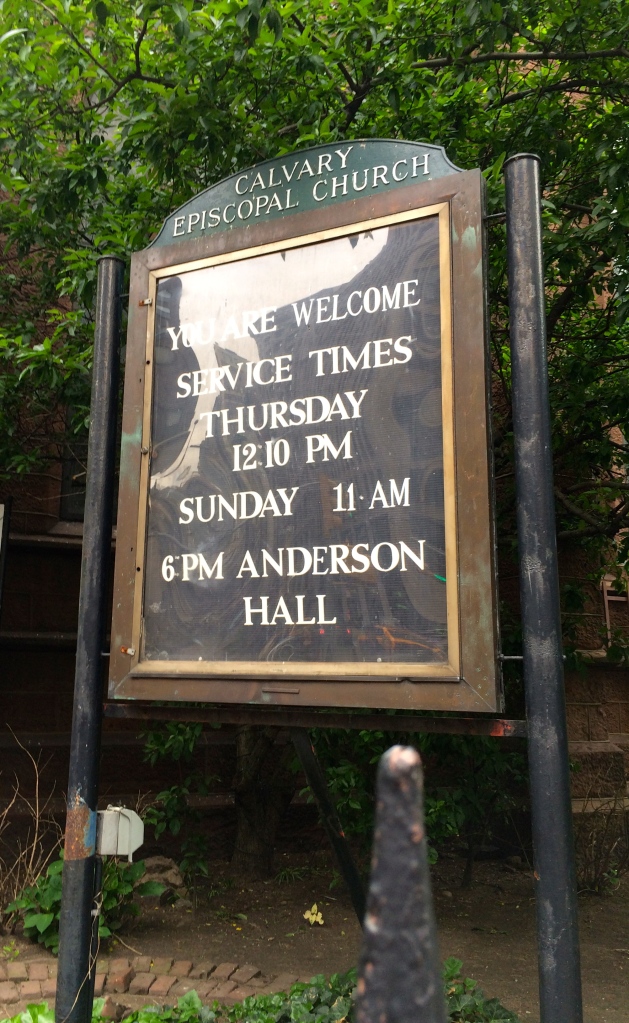 On the corner of 21st Street and Park Avenue, along the side of Calvary Episcopal Church, there runs a small fenced-in oasis of greenery amid the brownstone and concrete of the city. It wasn’t designed for people to walk in. But pigeons and mourning doves take full advantage. Also many little wren-like birds. (Trust me not to know their species.)
On the corner of 21st Street and Park Avenue, along the side of Calvary Episcopal Church, there runs a small fenced-in oasis of greenery amid the brownstone and concrete of the city. It wasn’t designed for people to walk in. But pigeons and mourning doves take full advantage. Also many little wren-like birds. (Trust me not to know their species.) 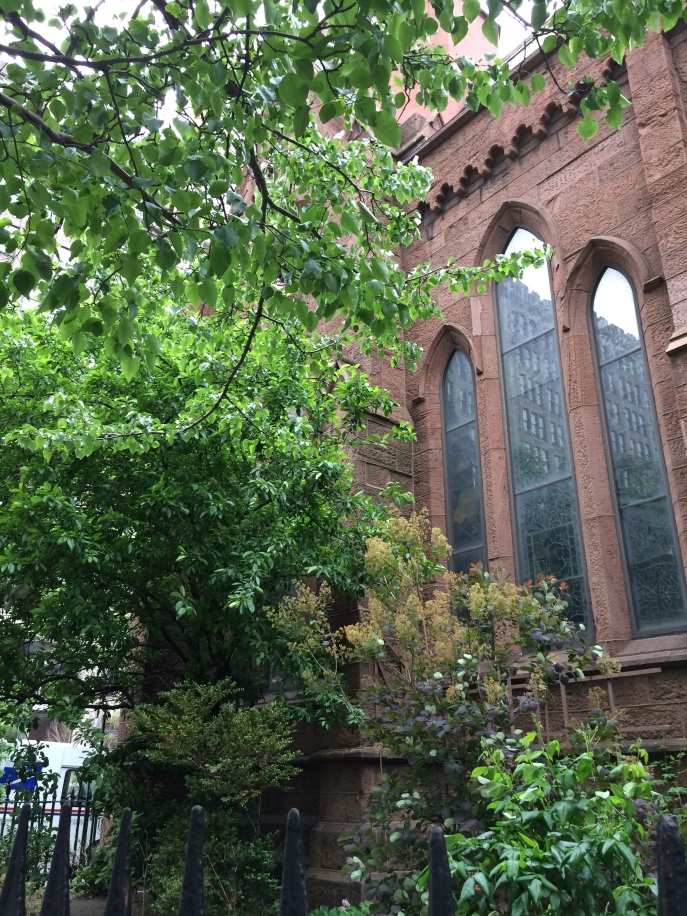 Passersby are certainly welcome to look at the Calvary garden. But most just hurry by. However, I had thirty minutes to spare before a dinner appointment in the neighborhood. Thank goodness for my trusty camera phone.
Passersby are certainly welcome to look at the Calvary garden. But most just hurry by. However, I had thirty minutes to spare before a dinner appointment in the neighborhood. Thank goodness for my trusty camera phone. 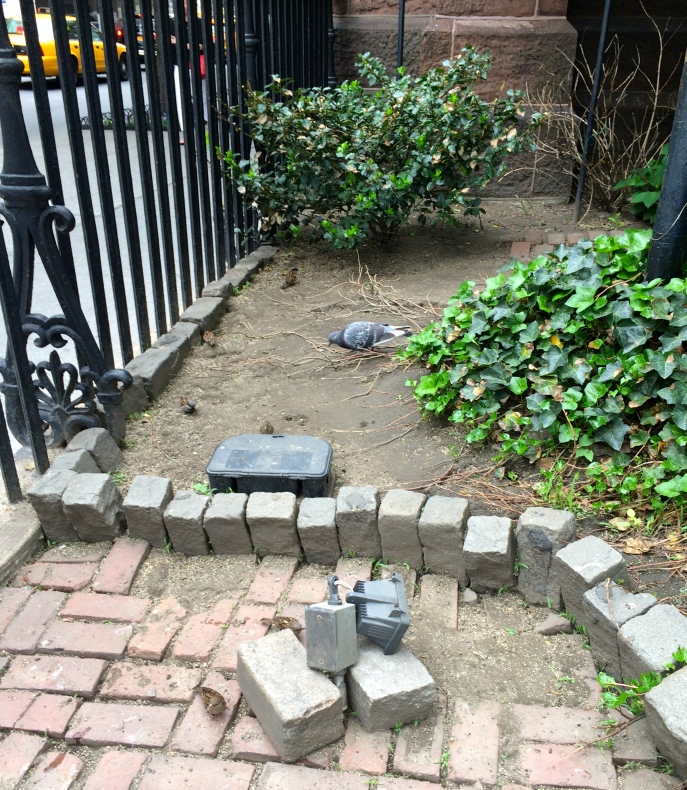
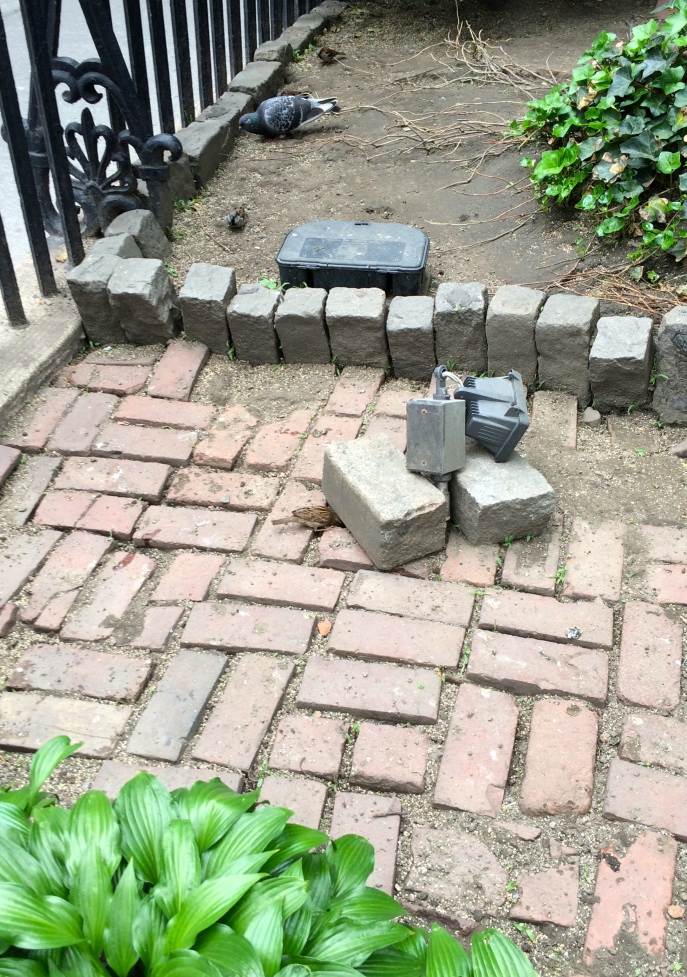
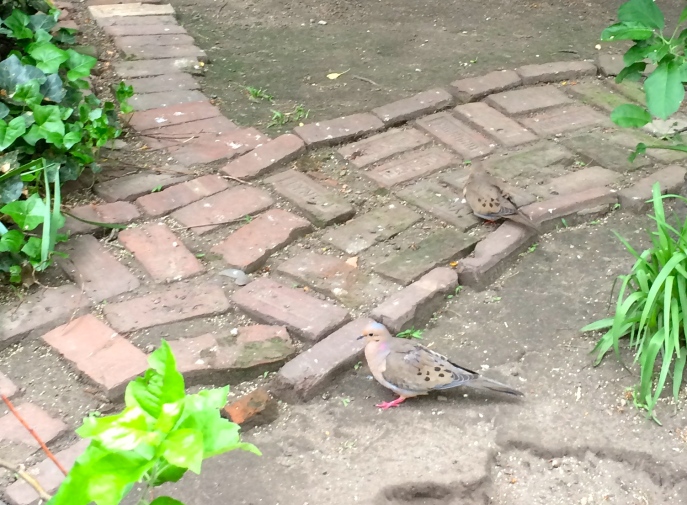 The second garden was designed for people. But not just any people.
The second garden was designed for people. But not just any people. 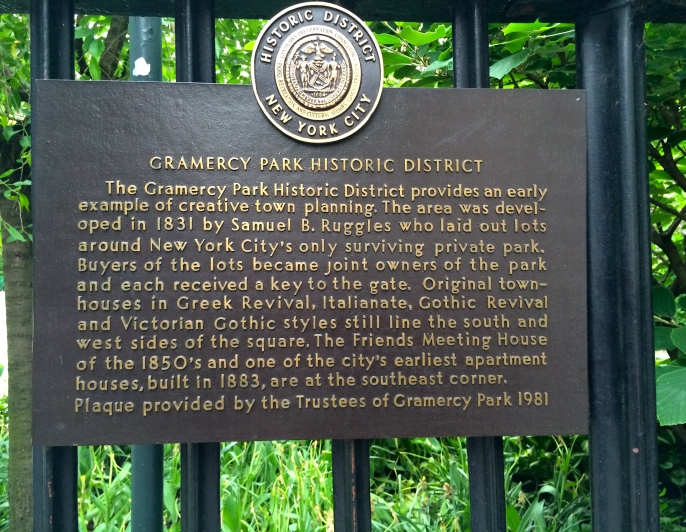 It’s called Gramercy Park, sits at the bottom of Lexington Avenue on East 21st Street, and occupies a whole fenced-in square block of prime Manhattan real estate. Unfortunately — and unlike Central Park far to the north, which was designed for all New Yorkers and visitors to enjoy — unless you are wealthy enough to inhabit an apartment or a townhouse overlooking Gramercy Park, you don’t get into this garden. Its four gates open only with an electronic passkey.
It’s called Gramercy Park, sits at the bottom of Lexington Avenue on East 21st Street, and occupies a whole fenced-in square block of prime Manhattan real estate. Unfortunately — and unlike Central Park far to the north, which was designed for all New Yorkers and visitors to enjoy — unless you are wealthy enough to inhabit an apartment or a townhouse overlooking Gramercy Park, you don’t get into this garden. Its four gates open only with an electronic passkey. 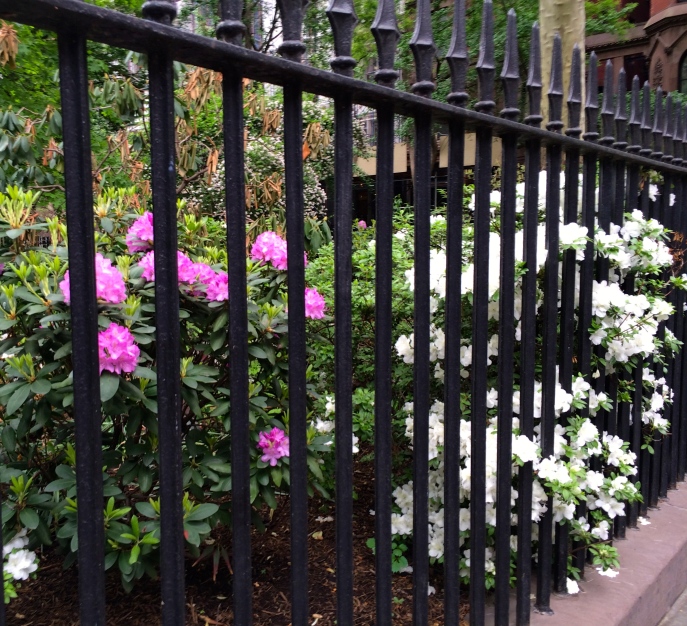 It’s so inhospitable there’s not even a bench or two on which to sit outside the park. If you’re tired of walking and want to rest for a few moments somewhat near “nature,” you have to perch ungracefully on the narrow curb below the ornamental black iron gates. The flowers reach out beyond the bars, as if to invite you in.
It’s so inhospitable there’s not even a bench or two on which to sit outside the park. If you’re tired of walking and want to rest for a few moments somewhat near “nature,” you have to perch ungracefully on the narrow curb below the ornamental black iron gates. The flowers reach out beyond the bars, as if to invite you in.  But the only way human beings without the electronic pass can circumvent the gates is by camera. Stick your hands between the bars and you can take pictures from inside, just as if you were really there.
But the only way human beings without the electronic pass can circumvent the gates is by camera. Stick your hands between the bars and you can take pictures from inside, just as if you were really there. 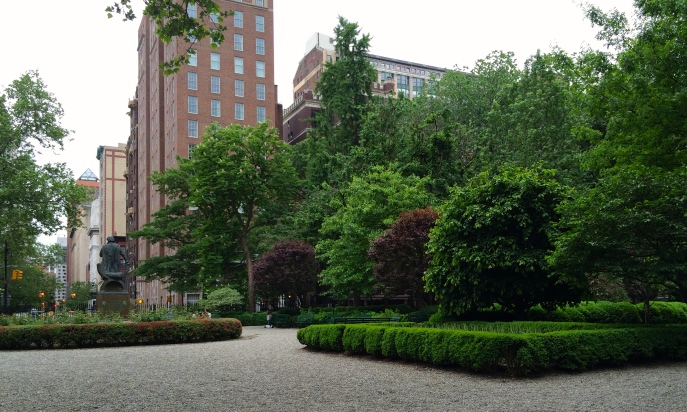
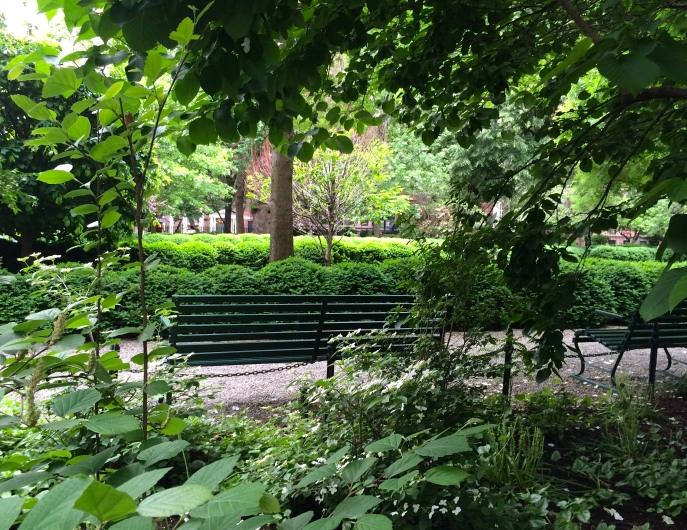 Having plenty of time, I walked all around the block-square private garden. I’d always known it belonged only to residents of the square, but had never spent any time nearby. Now as I circled it, I began to feel it wasn’t fair the park should be reserved, as it were, for the very rich.
Having plenty of time, I walked all around the block-square private garden. I’d always known it belonged only to residents of the square, but had never spent any time nearby. Now as I circled it, I began to feel it wasn’t fair the park should be reserved, as it were, for the very rich. 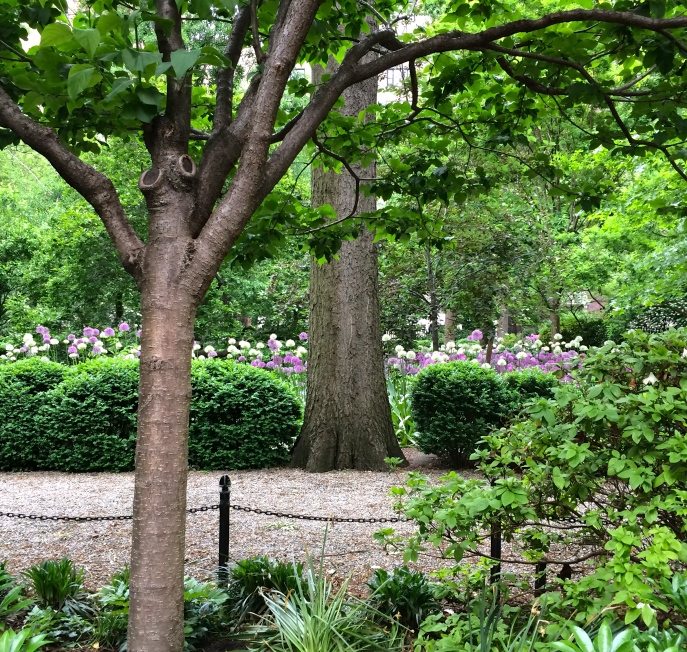
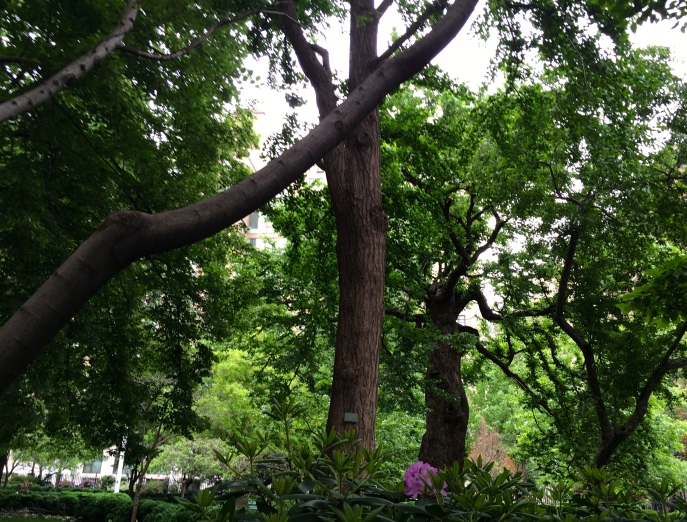 There are a few other encircled garden-like spaces in Manhattan, but they’re within a square of buildings, usually apartment houses. And those small “private” parks for the sole use of residents and their guests are not visible from the street. You have to enter one of the apartment houses to access them and don’t even know they exist unless you visit someone who lives there. Here, however, where I couldn’t go was in full view. I began to think of Haves and Have Nots.
There are a few other encircled garden-like spaces in Manhattan, but they’re within a square of buildings, usually apartment houses. And those small “private” parks for the sole use of residents and their guests are not visible from the street. You have to enter one of the apartment houses to access them and don’t even know they exist unless you visit someone who lives there. Here, however, where I couldn’t go was in full view. I began to think of Haves and Have Nots. 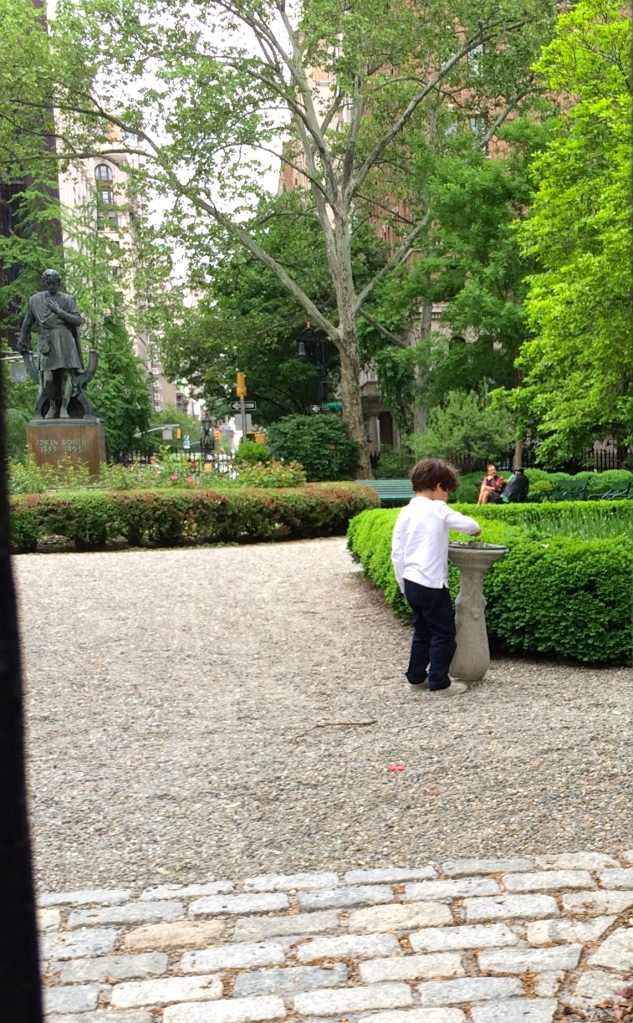 This little boy, for example, is the child of a Have. (Will he grow up with a strong sense of entitlement?) I am in no doubt that if I had purchased (had been able to purchase) a home fronting Gramercy Park — the price reflecting the value of access to a private and beautifully landscaped park — I wouldn’t want cyclists, bag ladies and tired tourists resting on “my” benches or anyone dropping cigarette butts and empty cans in “my” bushes.
This little boy, for example, is the child of a Have. (Will he grow up with a strong sense of entitlement?) I am in no doubt that if I had purchased (had been able to purchase) a home fronting Gramercy Park — the price reflecting the value of access to a private and beautifully landscaped park — I wouldn’t want cyclists, bag ladies and tired tourists resting on “my” benches or anyone dropping cigarette butts and empty cans in “my” bushes. 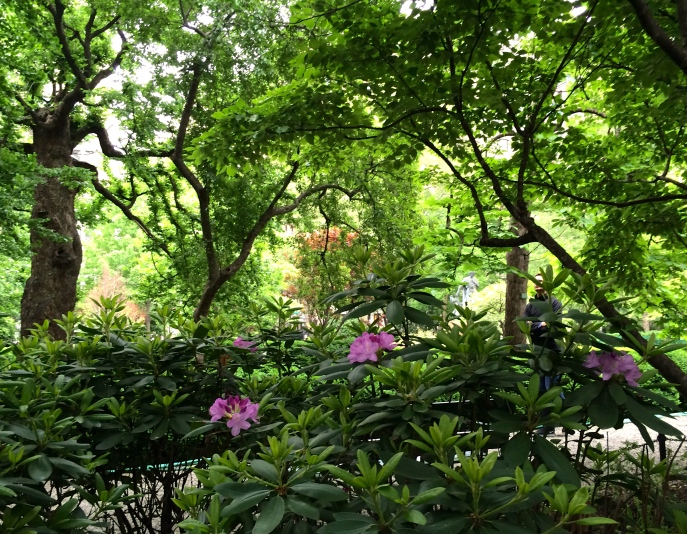 On the other hand, other than the little boy and his nanny, there was no one in the park except two elderly people on a bench and a jogger with white earbuds in a pink track suit going round and round the graveled inner path circling the garden all by herself. That whole square block of carefully tended plantings and flowerings was for just five people. It made me consider doing a piece called “Haves and Have Nots.” But I have no solution for issues as large as that, or even for what to do about the locked gates of the Gramercy Park garden. So I comforted myself with the thought that at least birds can get in.
On the other hand, other than the little boy and his nanny, there was no one in the park except two elderly people on a bench and a jogger with white earbuds in a pink track suit going round and round the graveled inner path circling the garden all by herself. That whole square block of carefully tended plantings and flowerings was for just five people. It made me consider doing a piece called “Haves and Have Nots.” But I have no solution for issues as large as that, or even for what to do about the locked gates of the Gramercy Park garden. So I comforted myself with the thought that at least birds can get in.  It looks better without the bars showing.
It looks better without the bars showing. 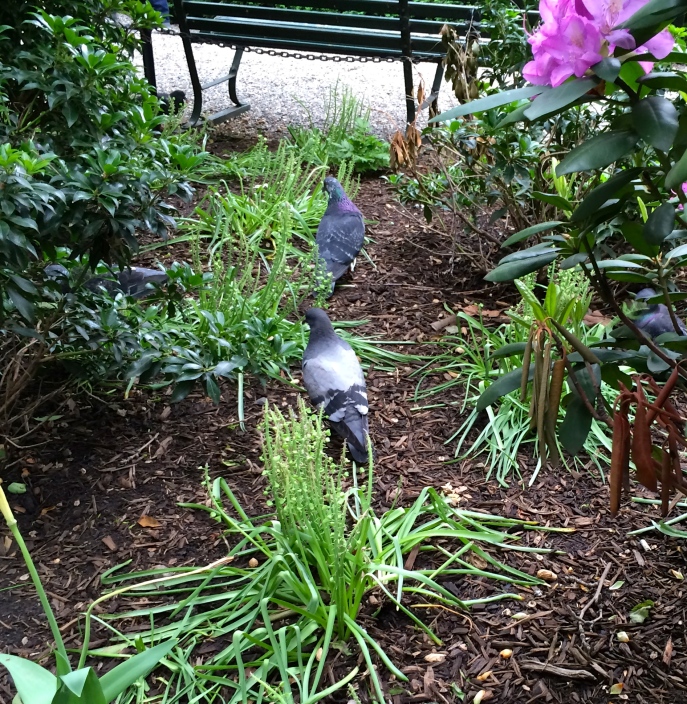 And then it was time for a luxurious early dinner across East 21st Street at Maialino, in the Gramercy Park Hotel, to which I’d been invited as a guest.
And then it was time for a luxurious early dinner across East 21st Street at Maialino, in the Gramercy Park Hotel, to which I’d been invited as a guest. 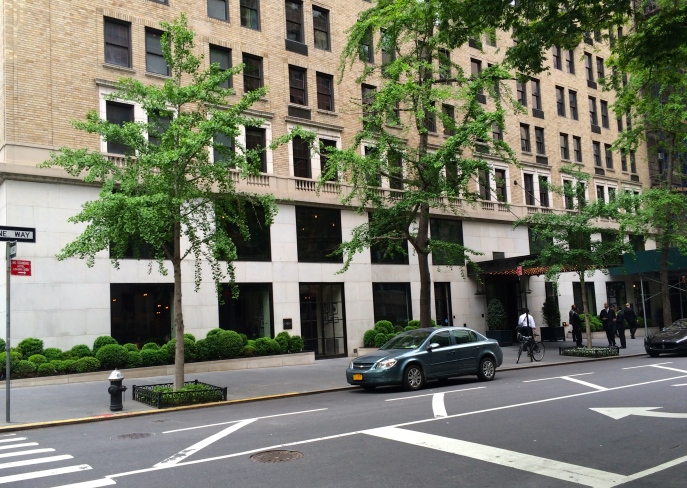 When you’re a guest, it’s ungrateful to be harboring simmering thoughts of Haves and Have Nots. Best to leave all that for another day.
When you’re a guest, it’s ungrateful to be harboring simmering thoughts of Haves and Have Nots. Best to leave all that for another day.

I suppose if I were a “have” I would want my private space too. My current financial planning to become a “have” is to win the lottery. I won’t start packing yet. It looks so beautiful.
LikeLiked by 1 person
Ooh, I’d like to win the lottery too. But I’m not holding my breath. I think I resent the closed gates on Gramercy Park so much not because I’m in that neighborhood very frequently (I’m not, hardly ever) or because I spend a lot of time on park benches enjoying beautiful views of nature and therefore feel deprived. It probably comes from a childhood with somewhat peripatetic parents, who when looking for a new place to live, frequently drove by neighborhoods posted with signs that read, “No pets, Jews or N—–s wanted here.” As a result, if anyone wants to keep me out of anything nowadays, I want in!
LikeLiked by 1 person
Who tends the park? I would probably try to slip in through the gates when the gardeners were tiding up or planting. If confronted by them ,as my obvious lack of money would immediately brand me an outcast, I would either put on my best superior English accent while looking down my nose, ( wouldn’t work – my nose is a snub one) or pretend I was lost because it looks so peaceful and beautiful that everyone should be allowed to see it. As long as no chewing gum , or rubbish was dropped. My pet hate in parks.
LikeLiked by 1 person
I doubt that slipping in behind the grounds keepers would work, Margaret. For one thing, you’d have to get wise to their schedule and then hang around (on foot) until they showed up. For another, there’s a sign by each gate reminding cardholders to lock the gate behind them when they enter. Yes, it does look peaceful and beautiful. But chewing gum? Rubbish? That’s the least of it. What about beer cans? Empty gin bottles? Let in the hoi polloi such as us, and there’s no telling what you’d find the next morning!
LikeLike
In my park you wouldn’t find gin bottles. I can’t drink it as it makes me cry. Now if you said brandy , I’m in.
LikeLike
Well, it’s theoretical, since it isn’t your park (or mine), and neither of us is getting in. 🙂
LikeLike
When I win the lottery , all is possible, though I don’t want a big house to go with it – too much cleaning. Love your comments.
LikeLiked by 1 person
You constantly take me by surprise, Nina! I had you marked off as Definitely Not Interested in Natural Beauty …
Here, for consideration in the Haves/Have Nots blog that might follow this one:
Perhaps the Haves would consider Open Days for the Have Nots — the first Saturday or Sunday of each month maybe–as a way to share their treasure, and ensure that it does not get ‘contaminated’ by arranging a few Haves volunteered to be on ‘duty’ to protect it.
LikeLiked by 1 person
You’re partially right about what I’m not very interested in, Gwen. But, as I remarked to Kate (above), I am very interested in not being prohibited from going anywhere I want to go. That said, I do think your idea about Open Days for the Have Nots is brilliant. Now if you could persuade the Trustees of Gramercy Park (presumably representing the interests of the key holders) to agree with you, that would really be something!
LikeLike
Beautiful pictures, serious thoughts, and like you I have not answers. But I will enjoy the beautiful pictures ❤
LikeLiked by 1 person
Thank you, Angie. If one leads a relatively comfortable life, and is not exposed in the day-to-day to the special comforts, privileges, enhancements and entitlements that Big Money can buy, it’s easy to forget the huge disparities of income — growing scarily larger every year — that exist in the United States. Gramercy Park was just a modest example. In fact, it had never really bothered me until I was in the neighborhood, tired of walking, and looking for somewhere to sit down and wait fifteen minutes until it was time to meet my host for dinner. Then it bothered me Big Time. I suppose the solution is to stay where you “belong” and — like Candide — tend your own garden. But I never liked being told what to do and where to be. Taking photos of what isn’t “yours” does help, though! 🙂
LikeLiked by 1 person
Seeing as I’m not near big money personally or environmentally, I can sit where and when I wish, gratefully! It is interesting when something unnoticed before comes to our attention. I imagine that it would just be too much to constantly see hardship so when we do see the pain, hopefully we have strength to help, even if just in a little way.
LikeLiked by 1 person
Lovely photos Nina, reminds me of ‘The Secret Garden.’
LikeLike
Thank you, Barbara. Re: “The Secret Garden” — as I recall, the heroine of that book was able to get in. The heroine of my story — namely, me — wasn’t! 😦
LikeLike
Beautiful photographs, and a great read as always, Nina.
However, I have a different take on your inaccessible garden. As a house-dweller, I have the good fortune to own a small (very small) back garden (pretty though it is, I think you would call it a ‘yard’). Behind my house, it is fenced off all round, as is common in the UK. We rarely, if ever, have those open environments so often seen in US subdivisions. Our acreage is smaller and we are all about fences! It’s mine, wholly mine, and I would be extremely miffed to say the least, to find a stranger clambering over the fence to sit and enjoy it. Indeed, they would be trespassing, and I would probably call the police!
To your fortunate ‘haves’ in New York, occupying their no doubt magnificent apartments overlooking the garden you enjoyed through the railings, that space, albeit shared between them, is just like my own back garden. I’ve paid to own it, to enjoy it with whoever *I* choose to invite. The fact that their shared garden sits, tantalisingly, in the midst of a population of ‘have nots’, its boundary of railings boasting to all and sundry what a privileged existence those ‘haves’ have, is perhaps uncomfortable – tasteless even. But their privilege, status, money, or whatever has bought them their elitist little patch of very expensive land. Whether we like it or not, it is theirs.
LikeLike
Ah Julie, good friend, spoken like a true landholder! And yes, I agree, however small your back garden or yard, it is indubitably yours, with or without a fence, and you are legally entitled to keep out interlopers, invite in friends, make it a thing of beauty or let it run to weed. However, I do believe the analogy of your garden with Gramercy Park is misconceived. Having read your comment, I immediately rushed off to Black’s Law Dictionary (which I still retain for moments such as this) to refresh my memory of real estate law, which even in this country is based on English legal precedents. Your yard is your “curtilage” — and here I quote from Black’s: (quoting federal law) “Originally, it referred to the land and outbuildings immediately adjacent to a castle that were in turn surrounded by a high stone wall; today its meaning has been extended to include any land or building immediately adjacent to a dwelling, and usually it is enclosed some way by a fence or shrubs.” (U.S. v. Romano, D.C. Pa, 388 F. Supp. 101,104); (quoting state law) “…the land or grounds surrounding the dwelling which are necessary and convenient and habitually used for family purposes and carrying on domestic employment: (State v. Hanson, 113 N.H. 689, 313 A.2d 730,732).
However (as I observed above), Gramercy Park is not at all like your own back garden. It is “adjacent” to nothing but four public streets. No resident is “surrounded” by the Park. Moreover, the original lot owners of the land on the other side of the four streets surrounding the Park were perhaps no more than thirty in number and together purchased from the city and put in trust a separate and unattached piece of land for their exclusive use so that it not be developed as the city grew. That, however, was about 185 years ago when the Gramercy district was at the very northern edge of the inhabited part of Manhattan; it was undoubtedly a proactive measure to keep the parcel opposite their homes unbuilt on. Those thirty townhouse owners are long since gone, and so are most of their houses. The Park is now mostly surrounded by tall modern apartment houses and sits squarely in the middle of a bustling city that prides itself on its public parks. It is not the “curtilage” of any one of those apartment owners, not even by legal extension, and I don’t believe they “own” anything except the right to use it. In a borough which has opened to the public not only Central Park running from 59th Street to 125th Street and from Fifth Avenue to Central Park West; Riverside Drive Park along the Hudson River; Jacob Riis Park on the East River; Fort Tryon Park in Washington Heights; and two gorgeous New York Conservancy gardens — one in the Village, another much bigger one off Fifth Avenue around 106th Street — Gramercy Park is not only “tasteless;” it’s a historical anomaly.
I wonder whether your relative tolerance for “privilege, status, money, or whatever” — when flaunted — may not be a particularly English quality, bred in the bone from centuries of monarchy and lords and ladies? Born lower-middle-class in America, and not having such privilege, status or money myself, it makes me bristle when I think of it. Which, I grant you, is not very often. I do like Gwen’s suggestion, though, although I have no idea at all as to how to make such a thing happen. Peace. 🙂
LikeLiked by 1 person
Ah, Nina… That’ll teach me to go up against a lawyer in a property matter!! 😀💐 I stand most resoundingly and delightfully corrected.
You make an equally interesting point about status and privilege. I don’t know if respect for privilege and status is in my British DNA, but I do know I personally tend to be a ‘rules girl’ – for good or ill. If I see a ‘keep out’ sign, I doubt I’ll ever be the girl caught scaling the fence!
LikeLiked by 1 person
Whatever my feelings about “rules,” I was never, and will never be, the girl caught scaling the fence either — for the simple reason that I was never agile enough to do such a thing, and now I’m certainly not!
LikeLiked by 1 person
How beautiful. I never knew that there are gardens in Manhattan. I am glad that told about them. Thank you.
LikeLike
You’re very welcome.
LikeLike